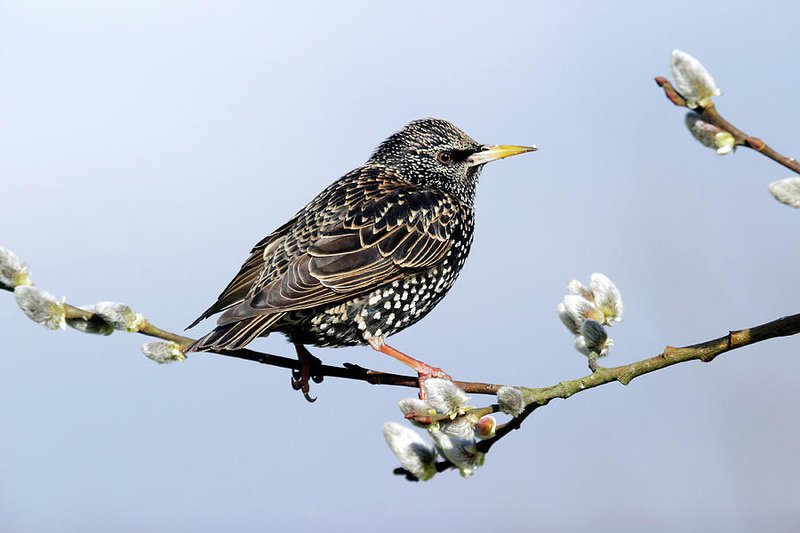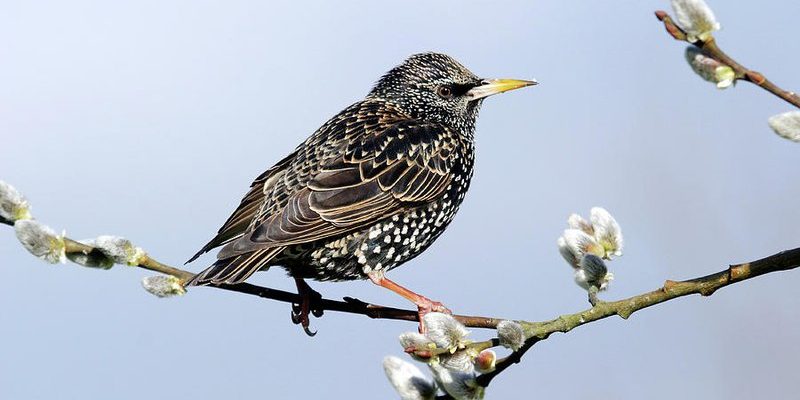
Have you ever noticed a bird that seems to shimmer with a rainbow of colors? That’s likely the European Starling, a fascinating bird that’s both beautiful and intriguing. Originally from Europe, these birds have made a name for themselves worldwide. Their glossy feathers can catch the light in mesmerizing ways, almost like tiny jewels flying through the air. But there’s so much more to these birds than their looks.
The European Starling is not just an ornamental bird; it has a compelling story and relationship with humans. They’re highly social and clever, often seen in large flocks that can be breathtaking to behold. You might be wondering what makes these birds tick, from their habits and diets to their remarkable behaviors. Let’s explore the world of the European Starling and uncover the many fascinating aspects of their lives.
Physical Characteristics
The European Starling is known for its compact body and striking appearance. Typically, they measure about 7.9 to 9.1 inches in length and have a wingspan of about 12 to 16 inches. A male European Starling tends to have a slightly larger build than females. One of the first things you’ll notice is their feathers, which exhibit a glossy black hue with flecks of white, brown, and metallic green or purple. This unique plumage reflects sunlight, giving them that shimmering look.
During the winter months, you might also observe their feathers transitioning to a more muted brown as they prepare for the colder weather. Although the change is subtle, it’s fascinating how nature works to adapt these birds to their environment. When it comes to their beaks, they have a pointed, conical shape, perfect for probing the ground for food. The beak starts off dark and transforms into a bright yellow during breeding season, adding another dash of brilliance to their appearance.
Habitat and Distribution
The European Starling is a versatile bird that thrives in a variety of habitats. From urban areas bustling with life to serene farmlands and open fields, they can adapt to almost any environment. Originally, they were primarily found in woodland edges and grasslands in Europe, but their resilient nature has allowed them to migrate and establish populations in a range of places, including North America, where they were introduced in the 19th century.
You’ll often find these birds nesting in cavities, whether in trees, man-made structures, or even in vents. Their adaptability helps them find safe nesting spots in both rural and urban settings. This is a testament to their survival skills. In cities, they often gather in parks and gardens, feeding on insects, fruits, and scraps left behind by people. It’s not uncommon to see them thriving in places you might not expect to find wildlife, making them a familiar sight in many areas.
Diet and Feeding Behavior
European Starlings are omnivorous birds, which means they eat a wide range of foods. Their diet mainly consists of insects, worms, fruits, and seeds. They are particularly fond of foraging on the ground, where they use their sharp beaks to probe the soil for hidden treasures. In spring and summer, you’ll often see them feasting on insects, which provide the protein they need for successful breeding.
In urban settings, their diet expands, as they might scavenge for leftover food in parks or dumpsters. One interesting aspect of their feeding behavior is their tendency to form large flocks while foraging. This not only makes finding food more efficient but also helps protect them from predators. You might witness an incredible display of coordinated movements as thousands of starlings twist and turn in the sky – a phenomenon known as murmurations. It’s as if they’re putting on a show just for us!
Reproduction and Breeding
The breeding season for European Starlings typically begins in late winter to early spring. During this time, males put on impressive displays to attract females. They will sing, puff out their feathers, and engage in acrobatic flight patterns to showcase their vitality. Once a pair has formed, they will seek out a suitable nesting location, often returning to the same spot year after year.
After laying about 4 to 6 eggs, the female incubates them for about two weeks before they hatch. Both parents play an active role in raising the young, bringing food back to the nest until their chicks can fly. It’s heartwarming to see how committed they are as parents. Once the babies have fledged, they tend to stick close to their parents for a while, learning essential survival skills before venturing out on their own.
Social Behavior and Flocking
European Starlings are incredibly social creatures. You often see them in large flocks, especially during migration or while foraging. This strong sense of community offers them protection against predators and allows them to communicate easily. Inside these flocks, they will engage in various behaviors, including grooming and playing, which helps strengthen their bonds with one another.
When the flock takes flight, it’s a sight to behold! Their synchronized movements create an intricate dance in the air, mesmerizing anyone lucky enough to witness it. This behavior, known as murmurations, isn’t just beautiful; it also serves a purpose. By moving together, starlings can confuse predators, making it harder for them to catch one bird in the ever-shifting mass of wings and bodies.
Conservation Status
The conservation status of European Starlings is one of mixed fortunes. While they are quite widespread and even considered abundant in many regions, their introduction to North America has sparked concern regarding their impact on native species. In some areas, they compete with native birds for food and nesting sites, sometimes resulting in negative consequences for local ecosystems.
However, their adaptability means they thrive in a range of environments. Conservation efforts mainly focus on understanding their ecological impact rather than outright protection, as their numbers remain significant. Research continues to explore ways to manage their populations while ensuring that the balance between native and non-native species is maintained.
Interesting Facts about European Starlings
| Size: | 7.9 to 9.1 inches long |
| Wingspan: | 12 to 16 inches |
| Diet: | Insects, fruits, seeds, human food |
| Lifespan: | 2 to 3 years in the wild |
| Nesting: | Cavities, tree holes, or man-made structures |
The European Starling is more than just a pretty bird; it’s a remarkable example of adaptability and social behavior. Their shimmering feathers, intriguing diet, and strong family bonds make them a captivating species to observe. Next time you see a flock of starlings gliding through the sky, take a moment to appreciate how these birds contribute to our ecosystem and the beauty of our natural world. Their presence can remind us of the intricate connections within nature that we often take for granted.
FAQ
What is the lifespan of a European Starling?
In the wild, European Starlings typically have a lifespan of about 2 to 3 years. However, some individuals may live longer, especially in protected environments. In captivity, where they are free from predators and have access to regular food sources, starlings can live up to 12 years or more.
Are European Starlings migratory birds?
European Starlings are considered partly migratory. While many individuals will migrate seasonally, especially in colder regions, others may stay year-round if conditions are favorable. Their migratory patterns can vary greatly depending on food availability and habitat conditions.
What do European Starlings eat?
European Starlings are omnivorous and have a varied diet. They primarily eat insects, worms, fruits, and seeds. In urban settings, they may also scavenge for human food scraps, making them adaptable feeders. Their diet changes with the seasons, focusing on insects during the breeding season and fruits in the fall.
How do European Starlings communicate?
Communication among European Starlings is quite complex. They use a variety of calls and songs to convey messages to one another, whether during courtship, foraging, or alerting others to predators. Their vocalizations can be loud and varied, adding to their social dynamics.
Why are European Starlings considered invasive in some regions?
In regions like North America, European Starlings are considered invasive because they compete with native bird species for food and nesting sites. Introduced in the 19th century, their rapid population growth has led to concerns over their impact on local ecosystems, prompting efforts to manage their numbers.
How can I attract European Starlings to my yard?
If you want to attract European Starlings to your yard, consider setting up bird feeders stocked with seeds and fruits, as they enjoy these foods. Providing water sources and nesting options, like birdhouses, can also make your yard more appealing to them. Just be aware that their presence might deter some native birds.
What other birds are similar to the European Starling?
Birds that resemble the European Starling include the Common Grackle and the Red-winged Blackbird. Both share some physical traits, like glossy feathers and similar sizes. However, their behaviors and calls can help you distinguish them from starlings once you get to know them better.
Do European Starlings mate for life?
No, European Starlings do not mate for life. Instead, they typically form monogamous pairs during the breeding season. After the chicks have fledged, they may separate, and both male and female can find new partners in the next season.
Can European Starlings be kept as pets?
While some people try to keep European Starlings as pets, they are wild birds and require specific care that can be challenging to provide in a home setting. In many places, keeping starlings as pets is illegal without special permits due to their status as non-native birds and their potential impact on local ecosystems.
What role do European Starlings play in their ecosystem?
European Starlings play a significant role in their ecosystem by helping to control insect populations and dispersing seeds through their feeding habits. Their foraging behaviors contribute to soil aeration and nutrient cycling, which benefits plant growth. Overall, they are integral to maintaining the balance in the environments they inhabit.
Where can I see European Starlings in the wild?
You can find European Starlings in various environments, from urban parks and gardens to farmlands and open fields. They are common in both rural and urban areas. If you’re keen to witness their spectacular murmurations, places with large open skies, such as parks during sunset, are often the best spots.

